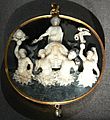Triton (mythology) facts for kids
Triton was a cool character in Greek mythology. He was the son of Poseidon, who was the powerful god of the sea. Triton worked as Poseidon's special messenger.
Contents
Meet Triton, the Sea God's Son
Triton was a very important figure in Greek myths. He was the child of Poseidon, the mighty god of the sea, earthquakes, and horses. His mother was Amphitrite, a beautiful sea goddess. Triton lived with his parents in a magnificent golden palace. This palace was located deep down at the bottom of the ocean.
Triton's Special Powers
Triton had a very unique and helpful power. He carried a special conch shell. This was not just any shell; it was a magical one. When Triton blew into his conch shell, he could control the ocean. He could make the rough, stormy seas become calm and peaceful. This power was very useful for sailors and for his father, Poseidon.
What Did Triton Look Like?
In ancient Greek art, Triton was often shown in a special way. He had the upper body of a man. But instead of legs, he had a long, powerful fish tail. This made him look a bit like a mermaid, but male. Sometimes, artists showed him with other interesting features. He might have arms that looked like the claws of a crab. Other times, his arms were drawn like the strong legs of a horse.
Many Tritons!
Sometimes, the myths talked about not just one Triton, but many. These were known as the Tritones. They were a group of sea spirits. They also had human upper bodies and fish tails. They often helped out in the sea, just like Triton did.
Triton in Space
The name Triton is still used today! One of the moons of the planet Neptune is named after him. This moon is called Triton. It's a very cold and icy moon. It was named after the Greek god because Neptune is also named after the Roman god of the sea, who is like the Greek Poseidon.
Images for kids
-
Cameo of Augustus in a quadriga drawn by tritons (Kunsthistorisches Museum)
-
The Triton Fountain (1642–3), by Gianlorenzo Bernini, Rome
See also
 In Spanish: Tritón (mitología) para niños
In Spanish: Tritón (mitología) para niños





